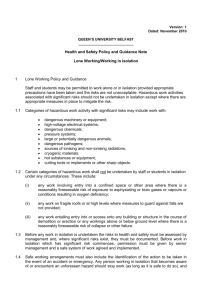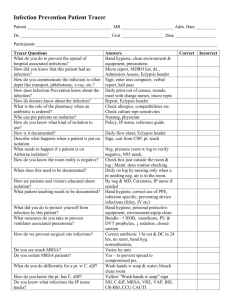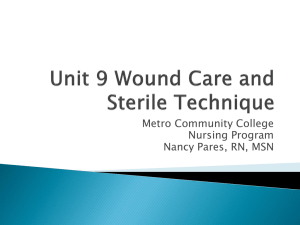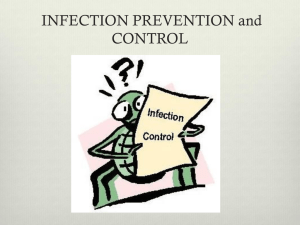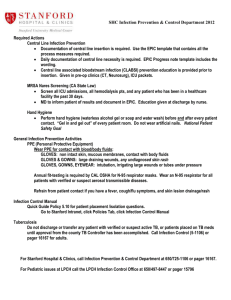Unit F: Infection Control
advertisement
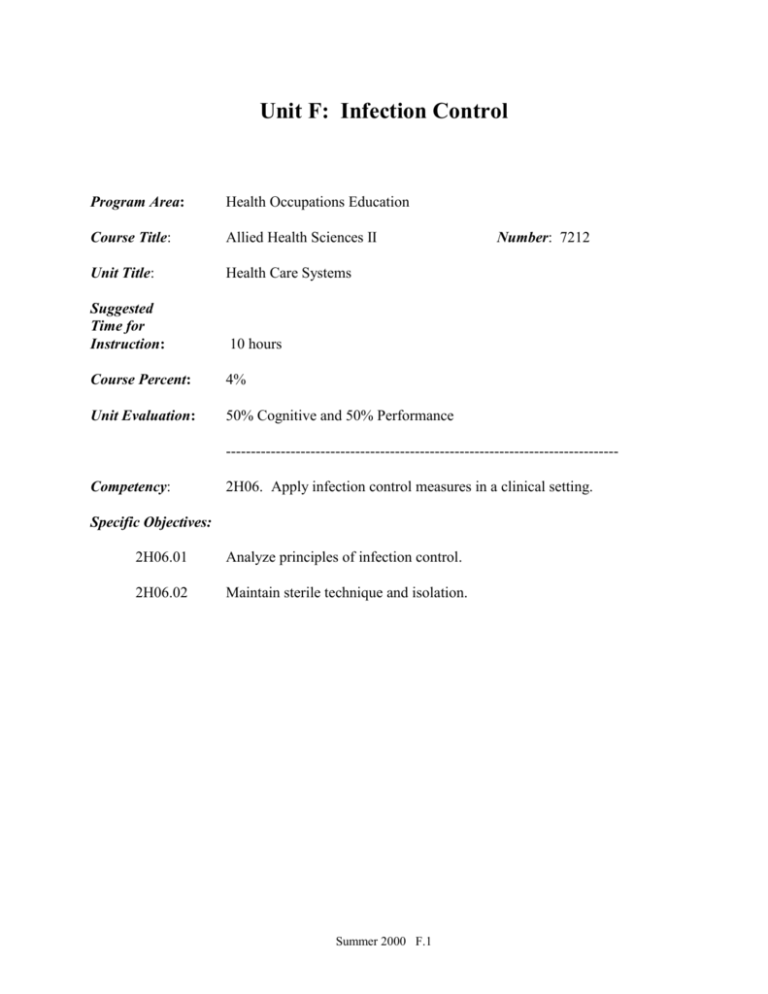
Unit F: Infection Control Program Area: Health Occupations Education Course Title: Allied Health Sciences II Unit Title: Health Care Systems Suggested Time for Instruction: 10 hours Course Percent: 4% Unit Evaluation: 50% Cognitive and 50% Performance Number: 7212 ------------------------------------------------------------------------------Competency: 2H06. Apply infection control measures in a clinical setting. Specific Objectives: 2H06.01 Analyze principles of infection control. 2H06.02 Maintain sterile technique and isolation. Summer 2000 F.1 Unit F Master Outline Unit F: Infection Control 2H06 Apply infection control measures in a clinical setting. 2H06.01 Analyze principles of infection control. A. Basic principles (disease transmission) 1. Microorganism 2. Pathogen/non-pathogen 3. Bacteria 4. Protozoa 5. Fungi 6. Rickettsiae 7. Viruses 8. Aerobic/anaerobic 9. Endogenous/exogenous/nosocomial/opportunistic 10. Chain of infection 11. Asepsis B. Handwashing * C. Standard precautions 1. HBV/HIV 2. OSHA regulations 2H06.02 Maintain sterile technique and isolation. A. Sterilization 1. Use of autoclave 2. Wrapping instruments for autoclave * B. Disinfection 1. Chemical disinfection 2. Boiling water 3. Ultrasonic unit C. Using sterile technique 1. Principles 2. Opening sterile packages 3. Sterile gloving * 4. Sterile dressing change D. Isolation 1. Types of isolation 2. Donning and removing isolation garments * Summer 2000 F.2 Unit F Infection Control Competency 2H06: Apply infection control measures in a clinical setting. Materials/Resources Simmers, Louise. Diversified Health Occupations. Delmar Publishers, 4th edition. National HOSA. HOSA Handbook, Section B. Published annually by the Health Occupations Students of America, Flower Mound, Texas. GloGerm Kit - May be purchased from: School Health Corporation 865 Muirfield Drive Hanover Park, IL 60103 1-800-323-1305 x 176 Microslides and Viewers may be purchased through various science catalogs. For example: Schoolmasters Science 745 State Circle, Box 1941 Ann Arbor, MI 48106 Phone orders: 1-800-521-2832 Carolina Biological Supply Co. 2700 York Road Burlington, NC 27215 1-800-334-5551 www.carolina.com Here are web sites you may want to use as resources for OSHA and infectious diseases: www.osha.gov www.cdc.gov Teaching/Learning Indicators: The following symbols are used to indicate specific skills/areas required in the instructional activity. Reading Social Studies Writing Science Math The Arts Health professional/parent/community involvement Summer 2000 F.3 Objective 2H06.01 Analyze principles of infection control. A. Basic principles (disease transmission) 1. Microorganism 2. Pathogen/non-pathogen 3. Bacteria 4. Protozoa 5. Fungi 6. Rickettsiae 7. Viruses 8. Aerobic/anaerobic 9. Endogenous/exogenous/nosocomial/opportunistic 10. Chain of infection 11. Asepsis B. Handwashing * C. Standard precautions 1. HBV/HIV 2. OSHA regulations Teaching/Learning Activities Basic Skills Have students complete the first two columns of the modified K-W-L Activity on the “Principles of Infection Control.” (Appendix 2H06.01A) Then, have students read Unit 12 in Diversified Health Occupations, pgs. 216-220, to complete the third column. Employability Skills Invite a health professional to talk to the class about Standard Precautions, OSHA regulations, and HBV/HIV. Suggestions include an Infection Control Nurse, representative from the American Red Cross or an environmental health professional. Have students take notes during the speaker’s presentation. Teamwork Have students work in pairs. Provide sealed slides of microorganisms for students to view under a microscope or a MicroSlide©. Note: This may be a good activity to integrate with a science teacher. Invite a medical technologist to assist with the activity and discuss their career. Critical Thinking Have students role-play situations related to standard precautions. (Appendix 2H06.01B) Cognitive Have students complete the worksheet, “Infection Control Review" as a review of principles for infection control. (Appendix 2H06.01C) Summer 2000 F.4 Objective 2H06.01 Analyze principles of infection control. Teaching/Learning Activities (Continued) Employability Skills After learning the proper technique for handwashing and successfully demonstrating the skill (Appendix 2H06.01D) have students teach younger students about handwashing using the GloGerm kit. Special Needs Each student will reach the highest level of mastery in the least restrictive environment as recommended in the student’s IEP. Summer 2000 F.5 Objective 2H06.02 Maintain sterile technique and isolation. A. Sterilization 1. Use of autoclave 2. Wrapping instruments for autoclave * B. Disinfection 1. Chemical disinfection 2. Boiling water 3. Ultrasonic unit C. Using sterile technique 1. Principles 2. Opening sterile packages 3. Sterile gloving * 4. Sterile dressing change D. Isolation 1. Types of isolation 2. Donning and removing isolation garments * Teaching/Learning Activities Cognitive Have students listen to a teacher-led presentation on sterilization, disinfection, and using sterile technique. Basic Skills Have students read pages 252-259 on isolation practices, and complete the "Isolation Matching" worksheet. (Appendix 2H06.02C) Employability Skills Invite a guest speaker to discuss isolation. Appropriate guest speakers may include a medical assistant or physician/nurse who specializes in infection control, communicable diseases, or burn treatment. Teamwork Following instruction and demonstration on wrapping instruments for autoclave (Appendix 2H06.02A), sterile gloving (Appendix 2H06.02B), and donning and removing isolation gowns (Appendix 2H06.02D), have students practice the skills in pairs with their partner evaluating each procedure. HOSA Following the guidelines for Extemporaneous Health Poster, have students create a poster following a topic provided by the teacher. Special Needs Each student will reach the highest level of mastery in the least restrictive environment as recommended in the student’s IEP. Summer 2000 F.6 Daily Lesson Plans Unit F: Lessons: Hours: Infection Control 6 10 clock hours Steps Lesson #1 Lesson #2 Lesson #3 Focus and Review Have students write a short answer to the question, “What do you know about microoganisms?” Have students exchange papers and grade “Infection Control Review” in class. Statement of Objectives 2H06.01 Analyze principles of infection control. Have students take a sheet of paper and tear it into 6 pieces labeled B (Bacteria), F (Fungi), P (Protozoa), R (Rickettsiae) and V (Virus). Then, call out infectious diseases. Students should select and hold up the correct paper. 2H06.01 Analyze principles of infection control. Teacher Input Discuss students’ answers to the focus and review question. Review correct answers to K-W-L activity. Demonstrate handwashing. After students have a chance to practice, complete skill check-off. After the guided practice activity, provide slides of microorganisms (using microscopes or Microslide viewer) and have students identify different kinds and shapes of microorganisms. Lecture on Standard Precautions (overheads in appendix) Have students complete the first two columns of the K-W-L activity “Principles of Infection Control.” Have students review concepts of Infection Control in pairs, then try to answer as many questions on the “Infection Control Review” as possible. Practice handwashing. Guided Practice In groups, have students role-play “Standard Precaution Scenarios” 2H06.01 Analyze principles of infection control. Have students listen to a teacherled presentation on use of an autoclave and disinfection. Once they complete the first two columns, they should read the chapter on Infection Control and then complete the third column. Independent Practice Complete the K-W-L assignment for homework. Complete the “Infection Control Review” as homework. Have students read the DHO sections on using an autoclave, and disinfection. Closure Ask students to name one thing they learned about microorganisms that they found surprising, or that they had never heard before. Materials DHO K-W-L worksheet Microscopes with slides and/or MicroSlide viewer. Have all students stand. Start around the room with one student naming an infectious disease and the next the causative organism. Keep going around the room until there is one student standing. Provide a reward. Overheads/projector Worksheet – Infection Control Review Rewards Ask students to answer the question – considering what you’ve learned about handwashing, how will you react in clinical areas when you see health professionals NOT following handwashing rules? DHO Overheads/projector Handwashing skill sheets Sink, soap, towels & hand brushes Summer 2000 F.7 Unit F: Infection Control (Continued) Steps Lesson #4 Lesson #5 Lesson #6 Focus and Review Ask students to evaluate "handwashing opportunities" in our school. Call on students to share answers to the homework assignment. Students will share their poster with the class in review for the test. Statement of Objectives 2H06.02 Maintain sterile technique and isolation. 2H06.02 Maintain sterile technique and isolation. 2H06.02 Maintain sterile technique and isolation. Teacher Input Have students listen to a teacherled presentation on sterile technique and changing sterile dressings. Invite a guest speaker to talk about isolation in a health care setting, and demonstrate donning and removing isolation garments. Test on “Infection Control.” Demonstrate wrapping instruments for autoclave, sterile gloving, and opening a sterile package. Using Extemp Health Poster guidelines, have students create a poster depicting one aspect of Infection Control. Practice wrapping instruments for autoclave and sterile gloving. Practice donning and removing isolation garments. Teacher will do check-offs on handwashing, wrapping instruments, and sterile gloving as students have mastered the skills. Teacher will complete check-offs for skills remaining in this unit. Guided Practice Note: Teacher will demonstrate opening a sterile package and sterile dressing change. Students do not need to be checked off on those two skills. Independent Practice As a homework assignment, have students complete the worksheet on "Isolation: Fact or Fiction." If time permits, grade the test in class. After test, complete any check-offs (skills) that have not been completed. Students will work on their posters when not performing skills for evaluation. Finish Extemporaneous Health Poster. Study for the test. Closure Ask students to go home and teach a young child the proper way to use a bandaid – keeping the pad sterile. Review important aspects of isolation technique. Tell students you will be beginning the Emergency skills unit - and to look over the section in DHO. Isolation supplies Skill check-lists Tests Answer Keys Tell students to bring one sheet of poster board to class the next day. Materials DHO Overheads/projector Materials for wrapping instruments Materials for sterile gloving Summer 2000 F.8 Unit F: Infection Control Terminology List 1. Aerobic 2. Anaerobic 3. Antisepsis 4. Asepsis 5. Autoclave 6. Bacteria 7. Boiling water 8. Cavitation 9. Chain of infection 10. Chemical disinfection 11. Clean 12. Communicable disease 13. Contaminated 14. Disinfection 15. Endogenous 16. Exogenous 17. Fungi 18. Isolation 19. Microorganism 20. Nonpathogens 21. Nosocomial 22. Opportunistic 23. Pathogens 24. Protective (reverse) isolation 25. Protozoa 26. Rickettsiae 27. Standard precautions 28. Sterile 29. Sterile field 30. Sterilization 31. Ultrasonic 32. Viruses Summer 2000 F.9 Name ________________________________________ Date _________________________ Principles of Infection Control Terms What I Know What I Want to Know What I Learned Pathogens Bacteria Protozoa Fungi Rickettsiae Viruses Aerobic/ Anaerobic Endogenous Exogenous Nosocomial Opportunistic Asepsis Appendix 2H06.01A Summer 2000 F.10 Name ________________________________________ Date _________________________ Standard Precaution Scenarios What should be used to protect health care workers? You should act out the following scenarios in small groups. 1. Stephanie is a new CNAI at Byrd General Hospital. As she walks into Room 541, she observes Mrs. Branch sitting in bed, holding her catheter in one hand and the side rail with the other. Blood is on the bed linens, siderails and floor. She yells “I couldn’t take another minute of pain with this thing sticking in me. I want to see Dr. Stubbs, now!” 2. Michael is attending phlebotomy school at night. He has been informed that gloves are a must when performing venipuncture. Michael is mentoring with Mrs. Hill, a MLT for 24 years. Upon entering the room of a gravely ill patient with a very productive cough, Mrs. Hill gets out a syringe, blood tubes, tourniquet, alcohol swabs, gauze and a bandaid. As Mrs. Hill applies the tourniquet, Michael asks “What about your gloves?” Mrs. Hill states, “I’ve been doing it like this for 24 years without any problems, and I can feel the vein better this way.” 3. Louisa is cleaning the room of a recently discharged tuberculosis patient. As she cleans the overbed table, she notices soiled wet tissues in the drawer, dried blood on the tray, and a suction liner still in the canister on the wall. Shen she moves the trashcan, she also finds a syringe with a needle intact lying on the floor. 4. Larry has decided to register for ASHII next year. Before he enters the hospital, several requirements must be met. He is not very happy because it means getting “shots” – and Larry has always been terrified of needles. 5. Stan needs to collect a sputum specimen from the patient in room 118 who is HIV positive. After collecting the specimen, he takes the cup and places it on the counter by the phone in order to complete the lab slip before taking the specimen to the lab. 6. Samantha and Carlita are Allied Health Sciences II students. They are helping a patient ambulate. The patient is recovering from a mild left-sided CVA. The patient states “I feel like I’m going to pass out” and suddenly stops breathing and falls to the floor. Samantha starts CPR while Carlita screams for help. Appendix 2H06.01B Summer 2000 F.11 Name ________________________________________ Date _________________________ Infection Control Review 1. Why does the body temperature increase when a person has an infection? 2. Should a health care worker who refuses the vaccine for Hepatitus B because of religious reasons be allowed to work as a hospital lab technician? 3. Efforts are made to get patients home from hospitals as soon as possible. What type of infection would be reduced by early discharge? 4. Fill in the blank with the most appropriate type of aseptic control? a. b. c. d. e. f. Surgical instruments Human hands Hypodermic needles A hospital bed Bedpan An abrasion on the knee _____________________________________ _____________________________________ _____________________________________ _____________________________________ _____________________________________ _____________________________________ 5. What type of equipment would a medical office buy in order to sterilize instruments? 6. Give four examples of portals of entry, and an example of an infection that could result? 7. Sometimes, severe infections are treated by placing a person in a hyperbaric chamber. What type of infection would that be? 8. Fill in the blank with the most appropriate classification of infection or disease? a. b. c. d. e. f. g. Hypothermia Pneumocystis carnii One transmitted by a health care worker Kaposi’s sarcoma Diabetes Sun poisoning Pseudomonas _____________________________________ _____________________________________ _____________________________________ _____________________________________ _____________________________________ _____________________________________ _____________________________________ Appendix 2H06.01C Summer 2000 F.12 ANSWER KEY: INFECTION CONTROL REVIEW 1. Why does the body temperature increase when a person has an infection? Higher body temperatures kill bacteria 2. Should a health care worker who refuses the vaccine for Hepatitis B because of religious reasons be allowed to work as a hospital lab technician? Yes. Risk is to the health care worker, not the patient 3. Efforts are made to get patients home from hospitals as soon as possible. What type of infection would be reduced by early discharge? Nosocomial 4. Fill in the blank with the most appropriate type of aseptic control? a. b. c. d. e. f. Surgical instruments Human hands Hypodermic needles A hospital bed Bedpan An abrasion on the knee sterilization antisepsis sterilization disinfection disinfection antisepsis 5. What type of equipment would a medical office buy in order to sterilize instruments? Autoclave 6. Give four examples of portals of entry, and an example of an infection that could result? Break in the skin = infected cut Respiratory tract = pneumonia Digestive tract = food poisoning Genitourinary tract = cystitis 7. Sometimes, severe infections are treated by placing a person in a hyperbaric chamber. type of infection would that be? Anaerobic 8. Fill in the blank with the most appropriate classification of infection or disease? a. b. d. d. e. f. g. Hypothermia Pneumocystis carnii One transmitted by a health care worker Kaposi’s sarcoma Diabetes Sun poisoning Pseudomonas What Exogenous Opportunistic Nosocomial Opportunistic Endogenous Exogenous Nosocomial and exogenous Name ____________________________________ Summer 2000 F.13 Date ________________________ 2H06.01D HANDWASHING MASTERY YES NO 1. Removed jewelry ____ ____ 2. Turned faucet on with paper towel and adjusted temperature ____ ____ 3. Wet hands and wrists thoroughly with fingertips pointing down ____ ____ 4. Applied soap to get lather on hands ____ ____ 5. Rubbed all surfaces of hands together several times ____ ____ 6. Interlaced fingers on both hands and rubbed them back and forth ____ ____ 7. Cleaned nails with an orange/cuticle stick and/or hand brush ____ ____ 8. Rinsed hands with fingertips pointed downward ____ ____ 9. Dried hands thoroughly, from tips of fingers to wrist ____ ____ 10. Turned faucet off with dry paper towel ____ ____ 11. Discarded towel(s) in wastebasket without contaminating hands ____ ____ 12. Did not lean against sink or touch inside of sink ____ ____ ____ ____ --------------------------------------- Mastery Non-Mastery TOTAL = 100% Yes = Below 100% Date __________ Evaluator ______________________________ Comments: Summer 2000 F.14 Name _______________________________ 2H06.02A Date ______________ WRAPPING INSTRUMENTS FOR AUTOCLAVE MASTERY YES NO 1. Gathered equipment ____ 2. Washed hands ____ ____ ____ 3. Thoroughly cleaned items in soapy water and rinsed in cool water ____ 4. Selected appropriate size wrap ____ ____ 5. Positioned wrap at a diagonal ____ ____ 6. Placed the item(s) in the center of the wrap, hinged instruments open ____ ____ ____ 7. Added internal autoclave indicator (if used) ____ ____ 8. Folded the bottom corner to center, folded back tab ____ ____ 9. Folded right corner to center, folded back tab ____ ____ 10. Folded left corner to center, folded back tab ____ ____ 11. Assured that edges were sealed, no air pockets ____ ____ 12. Brought the final corner up and over the package ____ ____ 13. Tucked this into pocket created by previous folds, leaving a small corner exposed ____ ____ 14. Checked edges to be sure they are sealed and tight ____ ____ 15. Secured with autoclave tape ____ ____ 16. Labeled tape with date and contents ____ ____ 17. Washed hands ____ ____ ____ ____ --------------------------------------Mastery Non-Mastery Date __________ TOTAL = 100% Yes = Below 100% Evaluator ______________________________ Comments: Summer 2000 F.15 Name ____________________________________ Date ________________________ 2H06.02B STERILE GLOVING MASTERY YES NO 1. Assembled equipment ____ ____ 2. Washed hands ____ ____ 3. Opened outer wrapper handling only the outside ____ ____ 4. Opened inner wrap: a. Handled only outside of wrap b. Maintained sterility of wrap and gloves c. Positioned with cuff end toward self ____ ____ ____ ____ ____ ____ 5. Donned first glove correctly: a. Grasped inside of glove with thumb and forefinger b. Lifted glove out and inserted other hand c. Donned glove while maintaining sterility ____ ____ ____ ____ ____ ____ 6. Donned second glove correctly: a. Puts sterile gloved hand under cuff b. Lifted glove out and inserted other hand c. Donned glove while maintaining sterility ____ ____ ____ ____ ____ ____ 7. Straightened cuff: a. Put gloved hand under cuff, pulling up and out b. Maintained sterility of glove ____ ____ ____ ____ 8. Removed gloves correctly: a. Removed first glove by grasping outside with the other gloved hand b. Pulled glove down over hand c. Removed second glove by placing ungloved hand inside the cuff d. Pulled glove down over hand e. Pulled glove inside out while removing f. Put contaminated gloves in proper waste container ____ ____ ____ ____ ____ ____ ____ ____ ____ ____ ____ ____ 9. Washed hands ____ ____ ----------------------------------------Mastery = 100% Yes Non-Mastery = Below 100% TOTAL Date __________ Evaluator _____________________ Comments: Summer 2000 F.16 ____ ____ Name ________________________________________ Date _________________________ Isolation: Fact or Fiction? Fill in the blank with "Fact" if the statement is true about isolation practices, or "Fiction" if the statement is NOT true. Be prepared to share the "true story" for the statements you mark as fiction. ________ 1. Isolation precautions always require the use of a gown, gloves and a mask. ________ 2. Isolation techniques are used for all hospitalized patients. ________ 3. Before gloving, remove rings and put them in your pocket or pin them to your uniform. ________ 4. Two people are required to take equipment out of an isolation unit. ________ 5. Many agencies use special isolation linen bags that dissolve in the washing machine. ________ 6. Protective isolation is the same thing as reverse isolation. ________ 7. A special two-room unit is necessary for isolation. ________ 8. Isolation is a method of caring for patients with a communicable disease. ________ 9. A patient with tuberculosis would be placed on Contact Precautions. ________ 10. Gloves should be removed after leaving an isolation room. ________ 11. A severely burned patient would be placed on Contact Precautions. ________ 12. It is best to leave patient care equipment (stethoscope, sphygmomanometer, etc.) in the room of an isolation patient. ________ 13. If you are wearing a mask in an isolation room and you sneeze, the first thing you should do is wash your hands. ________ 14. Gloves should be tucked under the sleeve of the isolation gown. ________ 15. The inside of a contaminated gown is considered clean. ________ 16. Metal utensils used for meals should be washed and remain in the isolation room for the next meal. ________ 17. After you've been in an isolation unit, the neck and waist ties of the gown are considered contaminated. ________ 18. Special filters are used in all isolation rooms to filter the air. ________ 19. A young, female health care worker who is susceptible to measles should NOT enter the isolation room of a patient with measles. ________ 20. A patient with severe viral influenza would not be placed on isolation. Appendix 2H06.02C Summer 2000 F.17 ANSWER KEY: Isolation: Fact or Fiction? Fill in the blank with "Fact" if the statement is true about isolation practices, or "Fiction" if the statement is NOT true. Be prepared to share the "true story" for the statements you mark as fiction. Fiction 1. Isolation precautions always require the use of a gown, gloves and a mask. Fiction 2. Isolation techniques are used for all hospitalized patients. Fact 3. Before gloving, remove rings and put them in your pocket or pin them to your uniform. Fact 4. Two people are required to take equipment out of an isolation unit. Fact 5. Many agencies use special isolation linen bags that dissolve in the washing machine. Fact 6. Protective isolation is the same thing as reverse isolation. Fiction 7. A special two-room unit is necessary for isolation. Fact 8. Isolation is a method of caring for patients with a communicable disease. Fiction 9. A patient with tuberculosis would be placed on Contact Precautions. Fiction 10. Gloves should be removed after leaving an isolation room. Fiction 11. A severely burned patient would be placed on Contact Precautions. Fact 12. It is best to leave patient care equipment (stethoscope, sphygmomanometer, etc.) in the room of an isolation patient. Fact 13. If you are wearing a mask in an isolation room and you sneeze, the first thing you should do is wash your hands. Fiction 14. Gloves should be tucked under the sleeve of the isolation gown. Fact 15. The inside of a contaminated gown is considered clean. Fact 16. Metal utensils used for meals should be washed and remain in the isolation room for the next meal. Fiction 17. After you've been in an isolation unit, the neck and waist ties of the gown are considered contaminated. Fiction 18. Special filters are used in all isolation rooms to filter the air. Fact 19. A young, female health care worker who is susceptible to measles should NOT enter the isolation room of a patient with measles. Fiction 20. A patient with severe viral influenza would not be placed on isolation. Summer 2000 F.18 Name ___________________________________ Date _____________________ 2H06.02D Donning and Removing Isolation Garments MASTERY YES NO 1. Assembled equipment ____ ____ 2. Washed hands ____ ____ 3. Removed rings ____ ____ 4. Placed watch in a plastic bag or on a paper towel 5. Put on mask correctly ____ ____ 6. Rolled up uniform sleeves (If needed) ____ ____ 7. Put on gown correctly: a. Kept hands inside shoulder b. Worked arms into sleeves c. Adjusted neck with hands inside neck band d. Tied at neck first e. Tied at waist f. Handled only inside of gown ____ ____ ____ ____ ____ ____ ____ ____ ____ ____ ____ ____ Put on gloves correctly ____ ____ ____ ____ 10. Removed gloves: a. Used gloved hand to grasp outside of opposite glove b. Pulled glove off inside out c. Placed hand under cuff to removed second glove d. Pulled glove off inside out e. Placed gloves in proper waist container ____ ____ ____ ____ ____ ____ ____ ____ ____ ____ 11. Washed hands thoroughly, operated faucet with towel ____ ____ 12. Removed mask, handling ties only, disposed of properly ____ ____ 13. Removed gown last: a. Untied neck ties b. Placed hand inside cuff and pulled sleeve over hand c. Placed covered hand on outside of gown, pulled gown sleeve over d. Eased out of gown gently e. Folded gown inside out and rolled it up f. Disposed of gown appropriately g. Touched only inside of gown ____ ____ ____ ____ ____ ____ ____ ____ ____ ____ ____ ____ ____ ____ 8. ____ ____ REMOVAL OF GARMENTS 9. Untied waist ties of gown first Summer 2000 F.19 2H06.02D Donning and Removing Isolation Garments (continued) 14. Washed hands thoroughly ____ ____ 15. Removed watch from towel or plastic bag without contamination ____ ____ 16. Opened door with towel, discarded towel in waste can ____ ____ 17. Washed hands immediately ____ ____ ----------------------------------------Mastery Non-Mastery TOTAL = 100% Yes = Below 100% Date __________ Evaluator _____________________ Comments: Summer 2000 F.20 ____ ____ Standard Precautions Sometimes called “Universal” precautions Used to break the chain of infection Pathogens spread by blood and body fluids - Hepatitis B (HBV) - Human immunodeficiency virus (HIV) OSHA passed regulations in 1991 requiring all health care facility employers to: - - Determine which employees will have exposure to blood and body fluids - Provide Hepatitis B vaccine free to employees with exposure risk (or signed refusal) Provide personal protective equipment (PPE) such as gloves, gowns, lab coats, masks, and face shields Provide adequate handwashing facilities and supplies Ensure clean & safe work environment Follow decontamination protocol for contaminated surfaces Dispose of infectious wastes correctly No eating, drinking, smoking, handling contact lenses, applying lip balm, etc. in risk area Summer 2000 F.21 Bioh azard Biohazard - Provide color-coded containers labeled for sharps and other infectious wastes - Post signs in work areas where this is exposure risk - Provide medical evaluation & follow-up for employees who’ve had an exposure incident - Provide training about the regulations to all employees at no cost during working hours Summer 2000 F.22 Standard precautions rules are developed by the CDC and FDA. 1. All body fluids should be considered potentially infectious 2. All patients should be considered potential sources of infection 3. Wash hands before and after any patient 4. If any surface comes in contact with blood or body fluids, wash immediately and thoroughly 5. Wash hands after removal of gloves 6. Wear gloves whenever contact with blood or body fluids is possible 7. Change gloves after contact with each patient 8. Gloves should not be reused 9. Gowns should be worn during any procedure with risk of splashing blood or body fluids 10. Masks and protective eyewear to be worn during procedures that may produce blood or body fluids 11. Extreme care should be taken while handling sharp objects. (Do not bend, break or recap needles. Dispose of them in puncture-resistant containers.) Summer 2000 F.23 12. Spills or splashes of blood or body fluids should be wiped up immediately. Wear gloves, and use a disinfectant solution. 13. Mouthpieces or resuscitation devices should be used to avoid the need for mouth-to-mouth resuscitation. 14. Know the requirements for disposal of waste materials and dispose of wastes in the proper container. 15. Report any cut, injury, needle stick, or splashing of blood or body fluids immediately. Summer 2000 F.24 Sterilizing with an Autoclave Uses steam under pressure or gas Destroys ALL microbes, pathogenic and nonpathogenic – including spores & viruses Before wrapping, instruments must be clean Wraps must allow for penetration of steam - Muslin - Autoclave paper - Special plastic or paper bags - Autoclave containers Indicators are used to ensure articles have been sterilized - Autoclave tape, sensitivity marks on bags or wraps, indicator capsules - Indicator will change appearance when sterile Autoclave must be loaded correctly Amount of time depends on the article to be sterilized – usually 15 – 30 minutes If wrap becomes torn or wet, it is contaminated Expires in 30 days Summer 2000 F.25 Disinfection Chemicals frequently used for aseptic control They do not kill spores & viruses so it’s not sterilization Used to disinfect instruments that don’t penetrate body tissue: - dental instruments - percussion hammers - thermometers Examples: - 90% isopropyl alcohol - formaldehyde-alcohol - 10% bleach solution - Lysol - Zephiran Boiling water disinfects but does not sterilize Satisfactory for home care where instruments/supplies used for one person only Usually 15-30 minutes Ultrasonic unit – used in dental & medical offices to disinfect Uses sound waves to produce millions of microscopic bubbles Cavitation – bubbles hit instrument and explode, driving cleaning solution into article Summer 2000 F.26 Sterile Technique - Principles Surgical Asepsis – procedures that keep an object or area free from living organisms Sterile – free from all organisms, including spores and viruses Contaminated – organisms/pathogens are present A clean, uncluttered work area necessary when working with sterile supplies Sterile field – sterile area – never reach across a sterile field – reach in from the side Never turn your back on a sterile field 2-inch border of sterile field is considered contaminated Common techniques: - Drop technique - Mitten technique - Transfer forceps Keep sterile field dry (pathogens travel through wet) and be careful when pouring fluids Be sure sterile field is open and ready before putting on sterile gloves Sterile gloves are contaminated on the inside – once on, keep hands away from body and above waist When in doubt, consider it contaminated Summer 2000 F.27 Opening Sterile Packages Check to be sure the sterile package has not expired Open the distal end and pull it away from you, reaching around the package, not across Open the sides without touching the inside wrapper Pull the bottom down toward you Drop technique Mitten technique Transfer forceps Summer 2000 F.28

